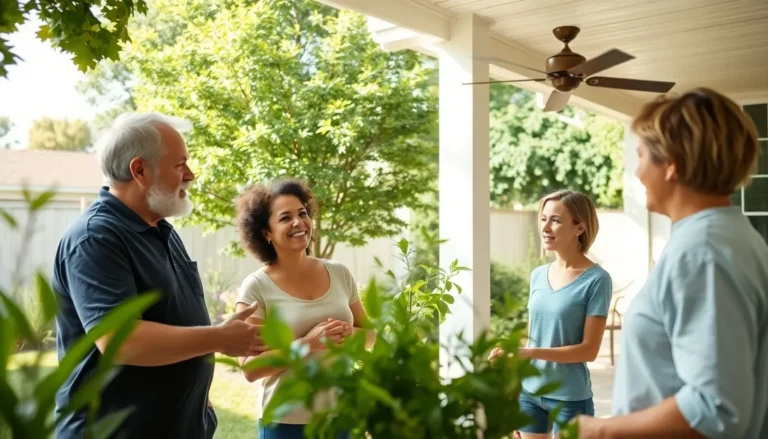Navigating the world of VA loans can feel like trying to find a needle in a haystack—if that needle was also a unicorn. But fear not! Understanding VA loan inspection requirements is your golden ticket to homeownership bliss. These inspections aren’t just bureaucratic hurdles; they’re your best defense against potential pitfalls lurking in your future home.
Table of Contents
ToggleUnderstanding VA Loan Inspection Requirements
VA loan inspection requirements ensure property suitability for veterans and active-duty service members. Inspectors check for safety, soundness, and sanitation in homes. Compliance with the Department of Veterans Affairs (VA) standards protects buyers from future hazards.
The VA mandates specific criteria. Homes must meet structural integrity to withstand various conditions. Safety hazards like exposed wires or rotting wood disqualify properties. Sanitation issues, including plumbing problems or mold growth, require resolution before loan approval.
Veterans can benefit from appraisal inspections. While appraisals focus on value, inspectors assess the livability of a property. They identify problems that might not affect value but could impact daily life. An inspector’s report may highlight urgent repairs essential for family safety.
Buyers should note the distinction between VA appraisals and inspections. Appraisals determine market value, while inspections address condition and safety. Understanding this distinction helps buyers make informed decisions.
Local regulations may influence inspections. Some states implement additional requirements beyond the VA’s standards. Familiarizing with these local rules is crucial for a smoother home-buying process.
Selecting a qualified inspector enhances the inspection process. Buyers may consult real estate agents for recommendations. Qualified inspectors often provide comprehensive reports detailing property conditions.
Overall, awareness of VA loan inspection requirements creates confidence in the home-buying journey. By understanding inspection expectations, veterans and service members can navigate their residential choices effectively. Prioritizing property safety ensures a stable living environment for them and their families.
Importance of VA Loan Inspections
VA loan inspections hold significant value for buyers, safeguarding against future issues in homes. These inspections focus on ensuring compliance with safety and living standards established by the Department of Veterans Affairs.
Protecting Homebuyers
VA loan inspections protect homebuyers by identifying potential hazards. Inspectors evaluate properties for safety, soundness, and sanitation. Any critical issues found during inspections trigger necessary repairs, preventing unexpected costs after purchase. Veterans and active-duty service members benefit from this proactive approach, as it ensures they invest in a property that meets specific safety requirements. Additionally, homebuyers gain peace of mind, knowing their chosen property fulfills the basic living standards outlined by the VA.
Ensuring Property Value
VA loan inspections also contribute to maintaining property value. Buyers often overlook the significance of inspections, but these assessments reveal structural integrity and potential long-term issues. A home that meets VA standards typically commands a better market position, assuring future buyers of its livability and safety. An inspection can also highlight repairs that enhance property values, ensuring investments are sound. Furthermore, awareness of these requirements helps buyers avoid properties that may lose value due to unforeseen maintenance concerns.
Key Inspection Areas for VA Loans
VA loan inspections focus on crucial areas to ensure homes meet safety and livability standards. Buyers find peace of mind when they understand these key inspection criteria.
Structural Integrity
Structural integrity plays a vital role in VA loan inspections. Inspectors evaluate the foundation, framing, and roofing for any signs of damage or decay. Cracks in the foundation or sagging roofs may indicate serious issues requiring immediate attention. Compliance with VA standards ensures the home is safe and sound for occupancy. Inspectors provide detailed reports, highlighting necessary repairs that protect the investment and ensure long-term durability. Veterans and active-duty service members benefit from knowing that their potential home meets these essential structural requirements.
Safety Hazards
Safety hazards are a top concern during VA inspections. Inspectors check for issues such as faulty wiring, inadequate plumbing, and unsafe heating systems. Gas leaks, electrical problems, and other hazards must be addressed to protect occupants. Ensuring proper ventilation and safe exits in case of emergencies is also critical. Properties that pass inspection contribute to a safe living environment. Identifying safety hazards early in the process helps buyers make informed decisions, safeguarding their future.
Pest Infestation
Pest infestation poses another concern for homebuyers utilizing VA loans. Inspectors assess the home for signs of termites, rodents, and other pests that can cause substantial damage. Active infestations or conditions conducive to pests are red flags. Addressing these problems ensures the structural integrity of the home remains intact. Buyers benefit from pest inspections, as they prevent future costly repairs associated with pest damage. Ensuring that homes are pest-free protects both the investment and the health of occupants.
Common Issues Found During Inspections
VA loan inspections frequently uncover various issues that can affect the safety and livability of a home. Being aware of these common problems can prevent future complications for buyers.
Roof Problems
Roof problems often surface during VA inspections. Inspectors check for missing shingles, leaks, and water damage. Damage in these areas raises concerns about structural integrity and future maintenance costs. Aging roofs may require replacement, especially if they show signs of significant wear. Observing any unevenness in the pitch or sagging can indicate underlying issues. Addressing roof problems promptly ensures safety and extends the home’s life.
Plumbing Issues
Plumbing issues frequently arise during inspections for VA loans. Inspectors examine pipes for leaks, corrosion, and proper functionality. Clogged drains and insufficient water pressure signal potential concerns that may require urgent attention. Mold growth often correlates with undetected leaks, further complicating health and safety matters. Additionally, outdated systems may not meet the current safety standards. Resolving plumbing issues before purchase enhances the home’s livability and protects the buyer’s investment.
Conclusion
Understanding VA loan inspection requirements is vital for veterans and active-duty service members embarking on the home-buying journey. These inspections not only safeguard buyers by identifying potential hazards but also ensure compliance with essential safety and livability standards. By addressing critical issues early on, homebuyers can avoid unexpected costs and maintain their property’s value over time. Selecting a qualified inspector further enhances this process, providing peace of mind and confidence in the investment. Ultimately, staying informed about these requirements empowers veterans and their families to make sound decisions, ensuring a safe and secure living environment.










